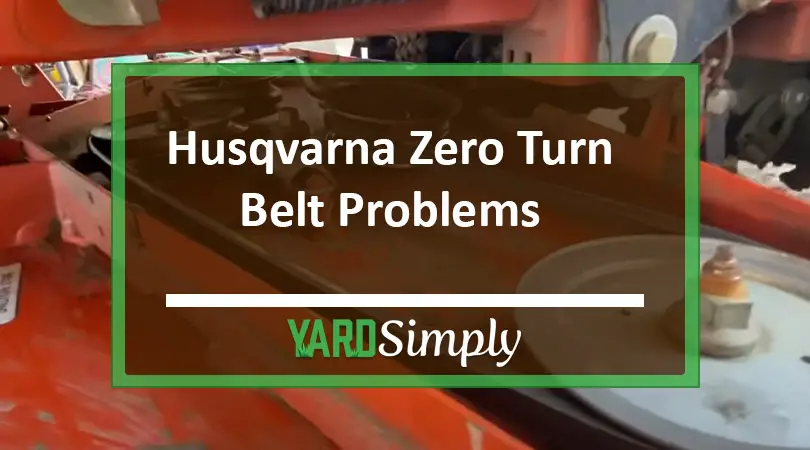As a seasoned lawn mower maintenance expert focusing on Husqvarna zero turn models, I bring a wealth of knowledge and practical experience to addressing belt problems.
My aim in this article is to provide you with concise, actionable insights derived from years of hands-on work. Trust in my guidance as we delve into common husqvarna zero turn belt problems and their solutions.
Quick Summary
- Identifying and solving common Husqvarna zero turn mower belt problems, such as worn or loose belts, debris buildup, and damaged belt keepers. Emphasizing the importance of prompt identification and resolution to maintain mower efficiency.
- I detail specific issues like worn or loose belts causing slippage, vibrations, and uneven cutting and recommend steps for inspection and replacement, including checking for wear, damage, and debris accumulation.
- Advise on preventative maintenance tips, such as regular cleaning, inspecting pulleys and spindle housings for wear or damage, and ensuring proper belt tension to avoid future problems and extend the mower’s lifespan.
- Highlights the importance of addressing pulley and bearing problems, instructing on how to identify and fix issues like bad bearings in pulleys and spindle housing bearing issues, which can lead to excessive vibration and belt disengagement.
Identifying Common Husqvarna Zero Turn Belt Issues
One commonly encountered issue is related to the mower belt, a pivotal component that transfers power from the engine to the mower deck, thus ensuring optimal cutting performance.
Frequent issues with Husqvarna mower belts, such as the Husqvarna belt, include worn or loose belts, debris buildup, and damaged belt keepers.
These problems can lead to belt disengagement and reduced mower performance, hence the need for prompt identification and resolution.
Let’s delve deeper into each of these issues and understand how to troubleshoot them effectively.
Learn More: Husqvarna Zero Turn Mower Problems: Expert Fixes
Worn or Loose Mower Belt
A worn or loose mower belt can cause a variety of problems, such as:
- Belt slippage or disengagement
- Vibrations
- High-pitched noise while mowing
- Uneven or scalloped grass cutting
- Excessive deck vibration
- Belt breakage
These issues arise due to normal use, wear, cracking, or damage to the belt, as well as other factors like damaged belt keepers, shredded deck belts, or damaged bearings in the pulley or spindle.
Begin the inspection and replacement of a worn or loose mower belt by following these steps:
- Look for signs of wear or damage like fraying, cracking, or glazing. The belt should be replaced if it is damaged. Get a new one.
- If the belt is not damaged, check for debris accumulation in the mower deck.
- Check for damaged belt keepers or faulty bearings in the pulleys or spindle housing.
Additionally, inspect the idler tensioner components for any worn brackets or springs, and ensure that the belt is properly tensioned.
Also Read: How To Replace Drive Belt On Husqvarna Zero Turn Mower
Debris Buildup in Mower Deck
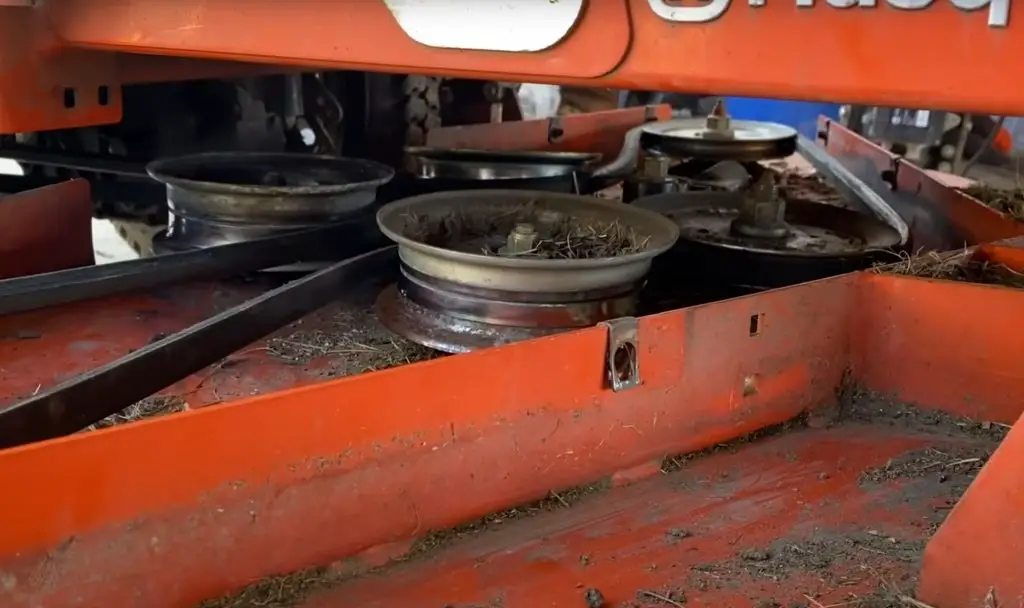
Debris buildup in the mower deck is another common issue that can lead to mower deck belt problems and even potential fire hazards. Some examples of debris that can accumulate in the mower deck include:
- Leaves
- Grass clippings
- Rocks
- Other large materials
When debris accumulate, they can interfere with the blade’s movement and cause the engine to work harder.
This can result in the blades becoming blocked and not rotating efficiently, leading to a decrease in mower performance and potential damage to the machine.
Regular cleaning of the mower deck and removing any accumulated material is key to preventing debris buildup. After each use, use a brush or compressed air to keep your mower deck clean, paying special attention to areas around the pulleys and tensioners.
Damaged Belt Keeper
The belt keeper is a rod installed around pulleys to prevent the deck belt from slipping off. If the belt keeper is damaged, it can cause the belt to dislodge from the pulley, leading to poor mower performance and potential damage to other components.
Signs of a damaged belt keeper include a loose or worn belt, shredded belt, bad bearings in the pulleys or spindle housings, and the damaged belt keeper itself.
To repair a damaged belt keeper, follow these steps:
- Start by looking for any signs of damage or displacement.
- If the belt keeper is slightly bent, you can straighten it with a hammer.
- If it is too rigid to bend back into its original position, replace it with a new one, ensuring you fasten the belt properly.
By repairing or replacing a damaged belt keeper, you can prevent belt slippage and ensure that your Husqvarna zero turn mower continues to operate efficiently with a new belt.
Addressing Pulley and Bearing Problems
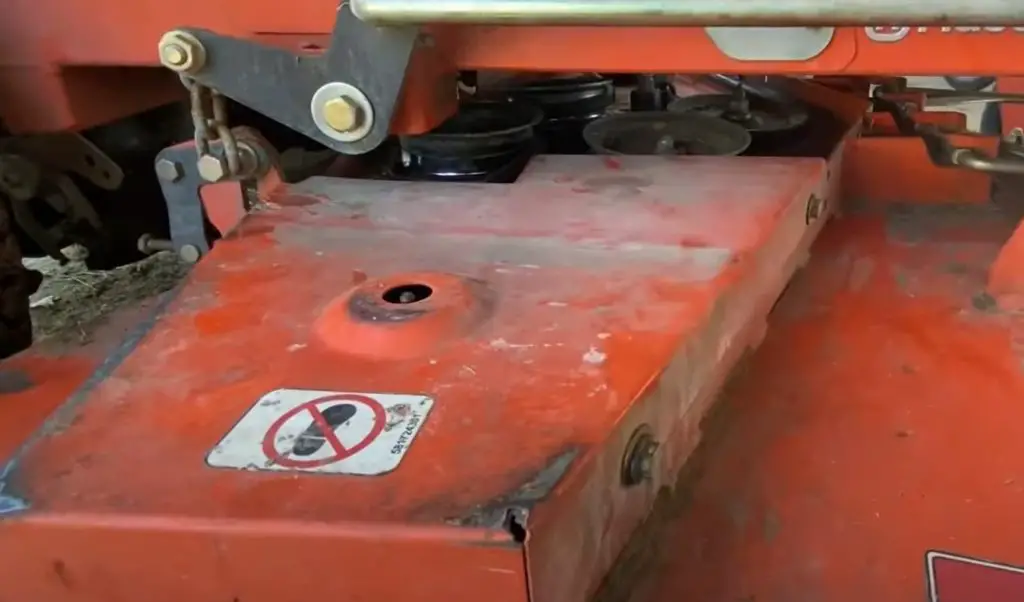
Pulley and bearing problems can also contribute to belt issues in Husqvarna zero turn mowers. When bearings in the pulleys or spindle housing become worn or damaged, they can cause:
- Excessive vibration
- Misaligned pulleys
- Belt slippage
- Belt disengagement
These issues can result in reduced mower performance and potential damage to other components.
Addressing these problems necessitates an inspection of the pulleys and spindle housing for any signs of wear or damage.
Related Articles:
Bad Bearings in Pulleys
Bad bearings in pulleys can cause excessive vibration, uneven pulley alignment, and belt slippage. To inspect and replace bad bearings in pulleys, first, check for any signs of wear or damage to the pulley or belt. If you find any issues, replace the pulley.
If the pulley is in good condition, inspect the bearings for any signs of rust or damage. If the bearings are damaged, replace them.
To determine whether a bearing in a pulley is faulty, follow these steps:
- Manually spin each pulley and observe the results.
- A functioning pulley should rotate smoothly.
- A pulley with a defective bearing will present resistance to rotation.
- Additionally, a sound may be emitted from the bearing, indicating the need for a replacement.
Spindle Housing Bearing Issues
Spindle housing bearing issues can cause vibration and belt disengagement, as well as premature wear and tear on the spindle assembly and other mower components.
To diagnose spindle housing bearing issues, access the underside of the deck and rock the blade or rotate the pulley slowly with your hand to detect any obstructions or noises.
Inspecting Idler Tensioner Components
Examining the idler tensioner components, including the tensioner pulley, is key to the upkeep of optimal belt performance and prevention of belt issues.
The idler tensioner components include the idler tensioner bracket and idler pulley, which work together to maintain the appropriate tension on the belt and prevent slippage.
Worn Idler Tensioner Bracket or Spring
A worn idler tensioner bracket or spring can cause belt slippage and vibration, reducing mower performance and potentially damaging other components.
Signs of a worn idler tensioner bracket or spring include shaking or bouncing of the idler pulley, excessive vibration, the drive belt jumping out of place, and the blades not engaging correctly.
Start the replacement of a worn idler tensioner bracket or spring by following these steps:
- Unhook the idler arm spring from the idler arm bracket retaining hole using needle-nosed pliers or a spring removal tool.
- Remove the old idler tensioner bracket or spring from the mower.
- Install the new idler tensioner bracket or spring in the same position.
Hook the idler arm spring back onto the idler arm bracket retaining hole and confirm that the idler tensioner bracket or tensioner spring is properly secured and in the correct position.
Ensuring Proper Tension
To adjust the tension on a Husqvarna zero turn belt, use a 10 mm wrench for bracket bolting and unbolting. Consult the owner’s manual or contact a Husqvarna authorized dealer for the appropriate tension specifications for your particular mower model.
If you notice any signs of improper tension, such as:
- Excessive deck vibration
- Belt squealing or slipping
- Belts excessively vibrating
- A decrease in power or cutting performance
It is essential to adjust the tension as needed. You can prevent belt issues and maintain optimal performance by ensuring proper tension in your mower’s belt system.
Dealing with Oil, Rust, and Debris Interference
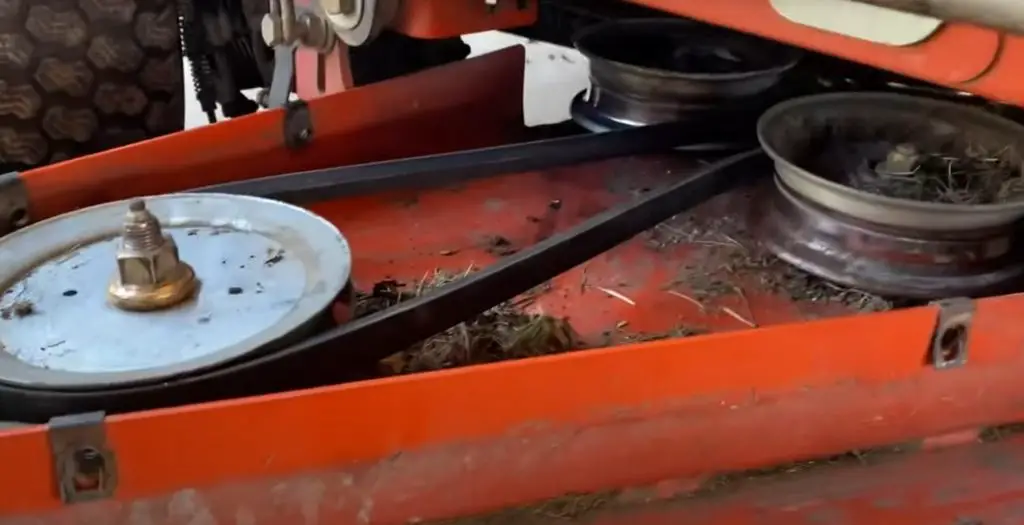
Interference from oil, rust, and debris can also lead to belt issues in Husqvarna zero turn mowers. Some common causes include:
- Oil leaks from the engine or cracked tubes and seals, which can cause oil buildup on the belt, leading to slippage and reduced traction.
- Rust on belts and pulleys, which can result in belt breakage and decreased mower performance.
- Debris in pulley grooves, which can cause the belt to slip and reduce power transmission.
Oil and Rust on Belt and Pulleys
Oil and rust on belts and pulleys can lead to slippage and detachment, resulting in reduced mower performance and potential damage to other components. To address these issues, follow these steps:
- Repair any oil leaks to prevent further contamination.
- Use Dawn dishwashing detergent to clean the affected areas.
- Scrub gently with a brush.
- Rinse thoroughly with water.
To prevent rust on belts and rusty pulleys, follow these steps:
- Clean the rust off using a wire brush.
- Apply a rust remover to remove any remaining rust.
- Lubricate with a rust inhibitor to prevent future rust formation.
Debris in Pulley Grooves
Debris in pulley grooves, such as:
- Stones
- Marbles
- Sticks
- Small rags
To prevent these issues, inspecting and cleaning the pulley grooves regularly is essential.
First, elevate the attachment lift lever to the highest position and verify the belt for proper routing in all mower pulley grooves. Examine for any debris lodged in the pulley grooves and remove it using a brush or compressed air.
Inspect the belt pulley grooves and flanges for wear and ensure that the belt is not running against the bottom of the groove.
Preventative Maintenance Tips
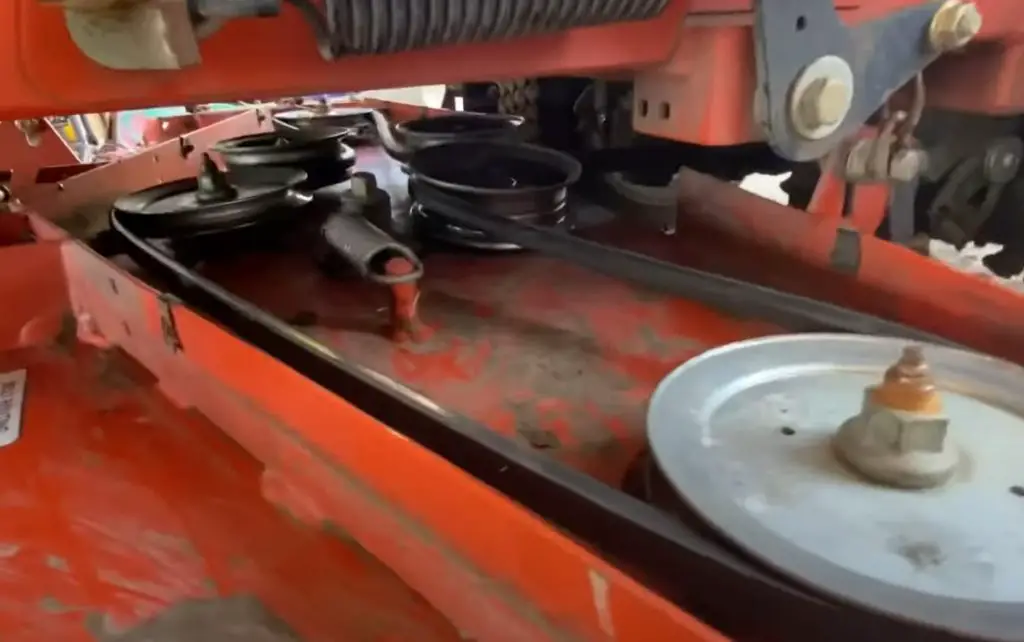
Adherence to preventative maintenance tips can help avoid common belt issues and prolong the lifespan of your Husqvarna zero turn mower.
Regular cleaning and inspection of your mower’s components can help prevent problems before they occur, ensuring that your mower continues to perform at its best.
Regular Cleaning and Inspection
After each use, clean the mower deck with a brush or compressed air to remove debris and grass clippings. Regularly check and replace the air filter, spark plugs, and oil to ensure proper airflow and engine performance.
Inspect the mower belt and pulleys for signs of wear, damage, or rust. If you notice any issues, replace the affected components to prevent further damage and maintain optimal performance.
By regularly cleaning and inspecting your mower, you can prevent common belt problems and ensure that your machine continues to operate efficiently.
Proper Storage and Care
Correct storage and care of your Husqvarna zero turn mower can aid in preventing issues like rust, oil leaks, and others that may lead to belt problems. Here are some tips to follow:
- Store your mower in a cool, dry place.
- Cover it with a tarp or weatherproof cover to protect it from the elements.
- Before storing the mower, check for signs of wear and tear.
- Clean any grass, leaves, or debris from the machine.
Adhere to battery storage instructions and perform regular maintenance tasks, such as checking the oil and fuel levels, and examining the mower for any signs of wear or damage.
By taking proper care of your Husqvarna zero turn mower and storing it correctly, you can prevent issues that may lead to belt problems and ensure that your mower remains in top condition.
Summary
Maintaining your Husqvarna zero turn mower’s belt and its associated components is essential for ensuring optimal performance and longevity.
By identifying and addressing common belt issues, such as worn or loose belts, debris buildup, and damaged belt keepers, you can prevent mower performance problems and costly repairs.
Regular cleaning, inspection, and proper storage are crucial preventative maintenance measures that can help you avoid belt problems and keep your mower running smoothly for years to come.
With the right care and attention, your Husqvarna zero turn mower will continue to provide you with a beautifully manicured lawn that you can be proud of.
Frequently Asked Questions
Why does my Husqvarna mower belt keep breaking?
The frequent breaking of your Husqvarna mower belt is likely due to worn out pulley bearings, which create friction and cause the belt to break.
How do I know if my mower belt is bad?
If you notice any cracks on your mower belt, even if they’re shallow, it is likely time to replace the belt as it is at risk of breaking.
How often do you need to replace a zero turn belt?
Mower belts need to be replaced periodically, depending on the operating conditions and how often it is used. It is important to consider replacing the belt more frequently if it has been used extensively.
How can I inspect and replace a worn or loose mower belt?
To inspect and replace a worn or loose mower belt, examine the belt for signs of damage, check for debris buildup in the mower deck, inspect idler tensioner components, and ensure that the belt is properly tensioned. If the belt is damaged, replace it with a new one.
How can I prevent rust on my Husqvarna zero turn mower belts and pulleys?
To prevent rust formation on your Husqvarna zero turn mower belts and pulleys, clean off any existing rust with a wire brush and apply a rust remover. Then lubricate the parts with a rust inhibitor to further protect them.

